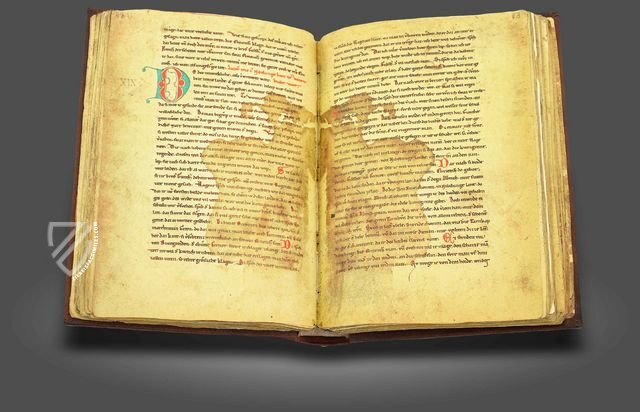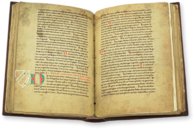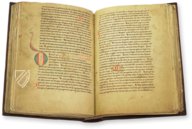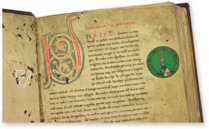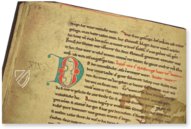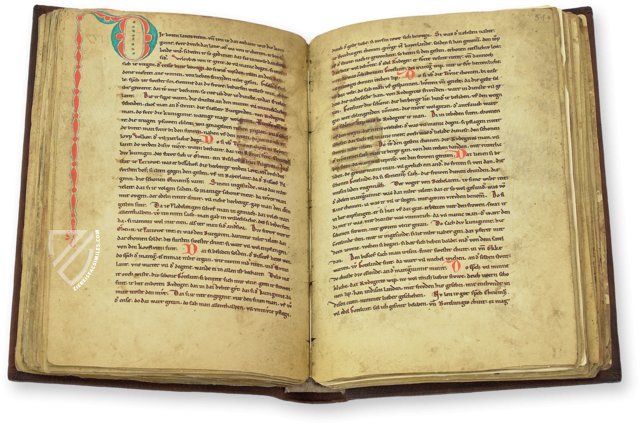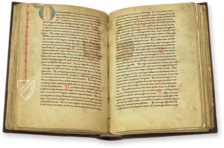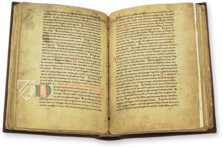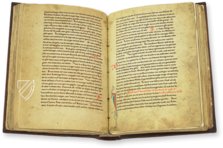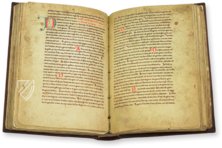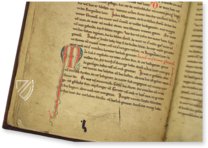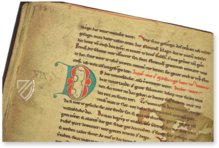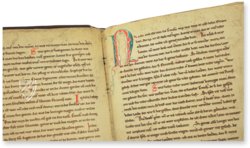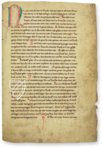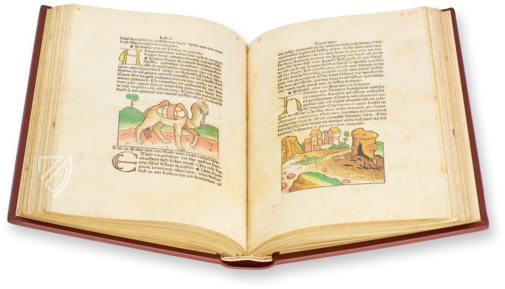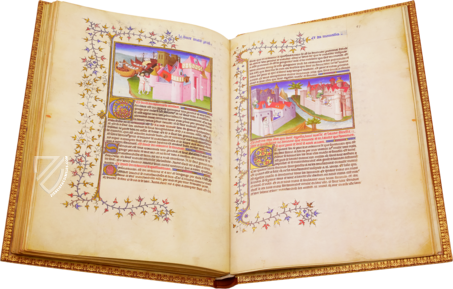Nibelungenlied und die Klage
(1,000€ - 3,000€)
The famous story surrounding the valiant Siegfried and his beloved Kriemhild, the wild Brünhild, and many more familiar protagonists belongs among the oldest literary evidence of the German language. After the saga was orally transmitted for centuries, the text was first recorded in writing ca. 1200. The Middle High German heroic epic was subsequently widely disseminated in manuscripts, some of which still survive today. The oldest and most comprehensive among them is the so-called Manuscript C or the Hohenems-Donaueschinger Manuscript, which probably dates from the second quarter of the 13th century and has been elevated to UNESCO World Documentary Heritage status because of its historical significance. The 114 leaves written in Protogothic minuscule are decorated with numerous large, two-color initials, the first of which is particularly ornate.
Nibelungenlied
Since 2001, this gem of linguistic and literary history has been kept in the Fürstlich Fürstenbergischen Hofbibliothek. The manuscript probably originates from the second quarter of the 13th century, presumably ca. 1230. This oldest transcript of the Nibelungenlied originates **from the Bavarian-Alemannic area and was written down in the language used in Tirol or Voralberg.
A Spectacular Discovery
The precious manuscript was forgotten for a long time and was first rediscovered in the 18th century. This sensational rediscovery aroused great scholarly and national enthusiasm. From the library of the dukes of Hohenems, the location of the spectacular find, the manuscript finally came into the possession of the Baron of Laßberg in 1816. After his death, the holdings joined the library of the princes of Fürstenberg, the Hofbibliothek Donaueshingen.
A Unique Textual Testimony
The famous Manuscript C contains the text of the Nibelungenlied and the Klage. In 2,439 strophes, the 39 ‘Aventiures’ of the Nibelungenlied are sung. The Klage is comprised of 4,427 verses. Among the three surviving 13th century manuscripts, Manuscript C takes on a special position as the oldest and most comprehensive, and is considered today to be the reference manuscript, upon which the field of research bases itself. As a sign of its significance, the Hohenems-Donauschinger manuscript of the Nibelungenlied has been raised to the status of a UNESCO Memory of the World Document.
“Uns ist in alten mæren, wunders vil geseit…”
Hiding behind the unadorned 114-page manuscript, bound in simple leather, is a true national epic, a tragic and exciting story of power and vengeance, love and hate. The beginning of the text is adorned with a beautifully colorful initial and the coat of arms of the Baron of Laßberg. The following text is continuously interfused with great red letters and colorful initials. Thus, the historical substance of the text comes entirely come into its own.
Codicology
- Alternative Titles
- Das Nibelungenlied und Die Klage: Handschrift C der F. F. Hofbibliothek Donaueschingen
The Song of the Nibelungs
Nibelungenlied - Size / Format
- 228 pages / 24.5 × 17.0 cm
- Origin
- Germany
- Date
- Second quarter of the 13th century
- Epochs
- Style
- Language
- Script
- Protogothic minuscule
- Illustrations
- Several fleuronnée initials
- Content
- A version of the epic poem "Nibelungenlied"
- Previous Owners
- Heinrich Durricher
Joseph Freiherr von Laßberg
Nibelungenlied und die Klage
Opening Page with Initial and Coat of Arms
This codex, referred to as Manuscript C among the surviving manuscripts of the Nibelungenlied, is considered to be authoritative and is text-forward with the original artistic adornment of the manuscript limited to fleuronnée initials in light blue and red as well as countless smaller red initials. Naturally, the opening page of the work has the largest and most elaborate initial with interlace filigree tendrils.
The heraldic medallion miniature in the right margin reads “Joseph von Laszberg, Knight” and refers to the German antiquarian Baron Joseph Maria Christoph von Laßberg, who acquired the manuscript in 1816. It is a 19th century addition that was intentionally executed in the Gothic style to make it look original and features his coat of arms with a decorative helmet set against a green diamond-patterned background with tiny gold stars.
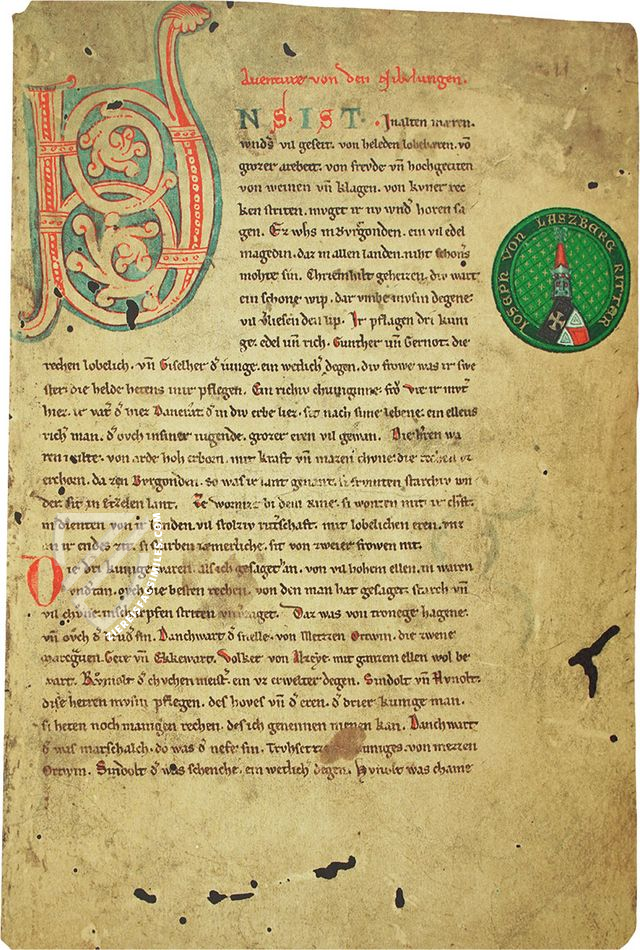
#1 Das Nibelungenlied und Die Klage: Handschrift C der F. F. Hofbibliothek Donaueschingen
Language: German
(1,000€ - 3,000€)
- Treatises / Secular Books
- Apocalypses / Beatus
- Astronomy / Astrology
- Bestiaries
- Bibles / Gospels
- Chronicles / History / Law
- Geography / Maps
- Saints' Lives
- Islam / Oriental
- Judaism / Hebrew
- Single Leaf Collections
- Leonardo da Vinci
- Literature / Poetry
- Liturgical Manuscripts
- Medicine / Botany / Alchemy
- Music
- Mythology / Prophecies
- Psalters
- Other Religious Books
- Games / Hunting
- Private Devotion Books
- Other Genres
- Afghanistan
- Armenia
- Austria
- Belgium
- Colombia
- Croatia
- Cyprus
- Czech Republic
- Denmark
- Egypt
- Ethiopia
- France
- Germany
- Greece
- Hungary
- India
- Iran
- Iraq
- Israel
- Italy
- Japan
- Lebanon
- Luxembourg
- Mexico
- Morocco
- Netherlands
- Palestine
- Peru
- Poland
- Portugal
- Russia
- Serbia
- Spain
- Sri Lanka
- Sweden
- Switzerland
- Syria
- Turkey
- Ukraine
- United Kingdom
- United States
- Uzbekistan
- Aboca Museum
- Ajuntament de Valencia
- Akademie Verlag
- Akademische Druck- u. Verlagsanstalt (ADEVA)
- Aldo Ausilio Editore - Bottega d’Erasmo
- Alecto Historical Editions
- Alkuin Verlag
- Almqvist & Wiksell
- Amilcare Pizzi
- Andreas & Andreas Verlagsbuchhandlung
- Archa 90
- Archiv Verlag
- Archivi Edizioni
- Arnold Verlag
- ARS
- Ars Magna
- ArtCodex
- AyN Ediciones
- Azimuth Editions
- Badenia Verlag
- Bärenreiter-Verlag
- Belser Verlag
- Belser Verlag / WK Wertkontor
- Benziger Verlag
- Bernardinum Wydawnictwo
- BiblioGemma
- Biblioteca Apostolica Vaticana (Vaticanstadt, Vaticanstadt)
- Bibliotheca Palatina Faksimile Verlag
- Bibliotheca Rara
- Boydell & Brewer
- Bramante Edizioni
- Bredius Genootschap
- Brepols Publishers
- British Library
- C. Weckesser
- Caixa Catalunya
- Canesi
- CAPSA, Ars Scriptoria
- Caratzas Brothers, Publishers
- Carus Verlag
- Casamassima Libri
- Chavane Verlag
- Christian Brandstätter Verlag
- Circulo Cientifico
- Club Bibliófilo Versol
- Club du Livre
- CM Editores
- Collegium Graphicum
- Collezione Apocrifa Da Vinci
- Comissão Nacional para as Comemorações dos Descobrimentos Portugueses
- Coron Verlag
- Corvina
- CTHS
- D. S. Brewer
- Damon
- De Agostini/UTET
- De Nederlandsche Boekhandel
- De Schutter
- Deuschle & Stemmle
- Deutscher Verlag für Kunstwissenschaft
- DIAMM
- Droz
- E. Schreiber Graphische Kunstanstalten
- Ediciones Boreal
- Ediciones Grial
- Ediclube
- Edições Inapa
- Edilan
- Editalia
- Edition Deuschle
- Edition Georg Popp
- Edition Leipzig
- Edition Libri Illustri
- Editiones Reales Sitios S. L.
- Éditions de l'Oiseau Lyre
- Editions Medicina Rara
- Editorial Casariego
- Editorial Mintzoa
- Editrice Antenore
- Editrice Velar
- Edizioni Edison
- Egeria, S.L.
- Eikon Editores
- Electa
- Emery Walker Limited
- Enciclopèdia Catalana
- Eos-Verlag
- Ephesus Publishing
- Ernst Battenberg
- Eugrammia Press
- Extraordinary Editions
- Fackelverlag
- Facsimila Art & Edition
- Facsimile Editions Ltd.
- Facsimilia Art & Edition Ebert KG
- Faksimile Verlag
- Feuermann Verlag
- Folger Shakespeare Library
- Franco Cosimo Panini Editore
- Friedrich Wittig Verlag
- Fundación Hullera Vasco-Leonesa
- G. Braziller
- Gabriele Mazzotta Editore
- Gebr. Mann Verlag
- Gesellschaft für graphische Industrie
- Getty Research Institute
- Giovanni Domenico de Rossi
- Giunti Editore
- Graffiti
- Grafica European Center of Fine Arts
- Guido Pressler
- Guillermo Blazquez
- Gustav Kiepenheuer
- H. N. Abrams
- Harrassowitz
- Helikon
- Hendrickson Publishers
- Henning Oppermann
- Herder Verlag
- Hes & De Graaf Publishers
- Hoepli
- Holbein-Verlag
- Hortus Deliciarum
- Houghton Library
- Hugo Schmidt Verlag
- Idion Verlag
- Il Bulino, edizioni d'arte
- ILte
- Imago
- Insel Verlag
- Instituto Nacional de Antropología e Historia
- Istituto dell'Enciclopedia Italiana - Treccani
- Istituto Ellenico di Studi Bizantini e Postbizantini
- Istituto Geografico De Agostini
- Istituto Poligrafico e Zecca dello Stato
- Italarte Art Establishments
- J. Thorbecke
- Jan Thorbecke Verlag
- Johnson Reprint Corporation
- Josef Stocker
- Josef Stocker-Schmid
- Jugoslavija
- Karl W. Hiersemann
- Kasper Straube
- Kaydeda Ediciones
- Kindler Verlag / Coron Verlag
- Kodansha International Ltd.
- Konrad Kölbl Verlag
- Kurt Wolff Verlag
- La Liberia dello Stato
- La Linea Editrice
- La Meta Editore
- Lambert Schneider
- Landeskreditbank Baden-Württemberg
- Leo S. Olschki
- Les Incunables
- Library of Congress
- Libreria Musicale Italiana
- Lichtdruck
- Lito Immagine Editore
- Lumen Artis
- Lund Humphries
- M. Moleiro Editor
- Maison des Sciences de l'homme et de la société de Poitiers
- Manuscriptum
- Martinus Nijhoff
- Maruzen-Yushodo Co. Ltd.
- MASA
- McGraw-Hill
- Militos
- Millennium Liber
- Müller & Schindler
- Nahar and Steimatzky
- National Library of Wales
- Neri Pozza
- Nova Charta
- Oceanum Verlag
- Odeon
- Orbis Mediaevalis
- Orbis Pictus
- Österreichische Staatsdruckerei
- Oxford University Press
- Pageant Books
- Parzellers Buchverlag
- Patrimonio Ediciones
- Pattloch Verlag
- PIAF
- Pieper Verlag
- Plon-Nourrit et cie
- Prestel Verlag
- Princeton University Press
- Prisma Verlag
- Priuli & Verlucca, editori
- Pro Sport Verlag
- Propyläen Verlag
- Pytheas Books
- Quaternio Verlag Luzern
- Reales Sitios
- Recht-Verlag
- Reichert Verlag
- Reichsdruckerei
- Riehn & Reusch
- Roberto Vattori Editore
- Rosenkilde and Bagger
- Roxburghe Club
- Salerno Editrice
- Sarajevo Svjetlost
- Schöck ArtPrint Kft.
- Scolar Press
- Scrinium
- Scripta Maneant
- Scriptorium
- Siloé, arte y bibliofilia
- SISMEL - Edizioni del Galluzzo
- Sociedad Mexicana de Antropología
- Société des Bibliophiles & Iconophiles de Belgique
- Soncin Publishing
- Sorli Ediciones
- Stainer and Bell
- Studer
- Styria Verlag
- Sumptibus Pragopress
- Szegedi Tudomànyegyetem
- Taberna Libraria
- Tarshish Books
- Taschen
- Tempus Libri
- Testimonio Compañía Editorial
- Thames and Hudson
- The Clear Vue Publishing Partnership Limited
- The Facsimile Codex
- The Folio Society
- The Marquess of Normanby
- The Richard III and Yorkist History Trust
- Tip.Le.Co
- TouchArt
- TREC Publishing House
- TRI Publishing Co.
- Trident Editore
- Typis Regiae Officinae Polygraphicae
- Union Verlag Berlin
- Universidad de Granada
- University of California Press
- University of Chicago Press
- Urs Graf
- Vallecchi
- Van Wijnen
- VCH, Acta Humaniora
- VDI Verlag
- VEB Deutscher Verlag für Musik
- Verlag Anton Pustet / Andreas Verlag
- Verlag Bibliophile Drucke Josef Stocker
- Verlag der Münchner Drucke
- Verlag für Regionalgeschichte
- Verlag Styria
- Vicent Garcia Editores
- W. Turnowsky
- Waanders Printers
- Wiener Mechitharisten-Congregation (Wien, Österreich)
- Wissenschaftliche Buchgesellschaft
- Wydawnictwo Dolnoslaskie
- Xuntanza Editorial
- Zakład Narodowy
- Zollikofer AG

